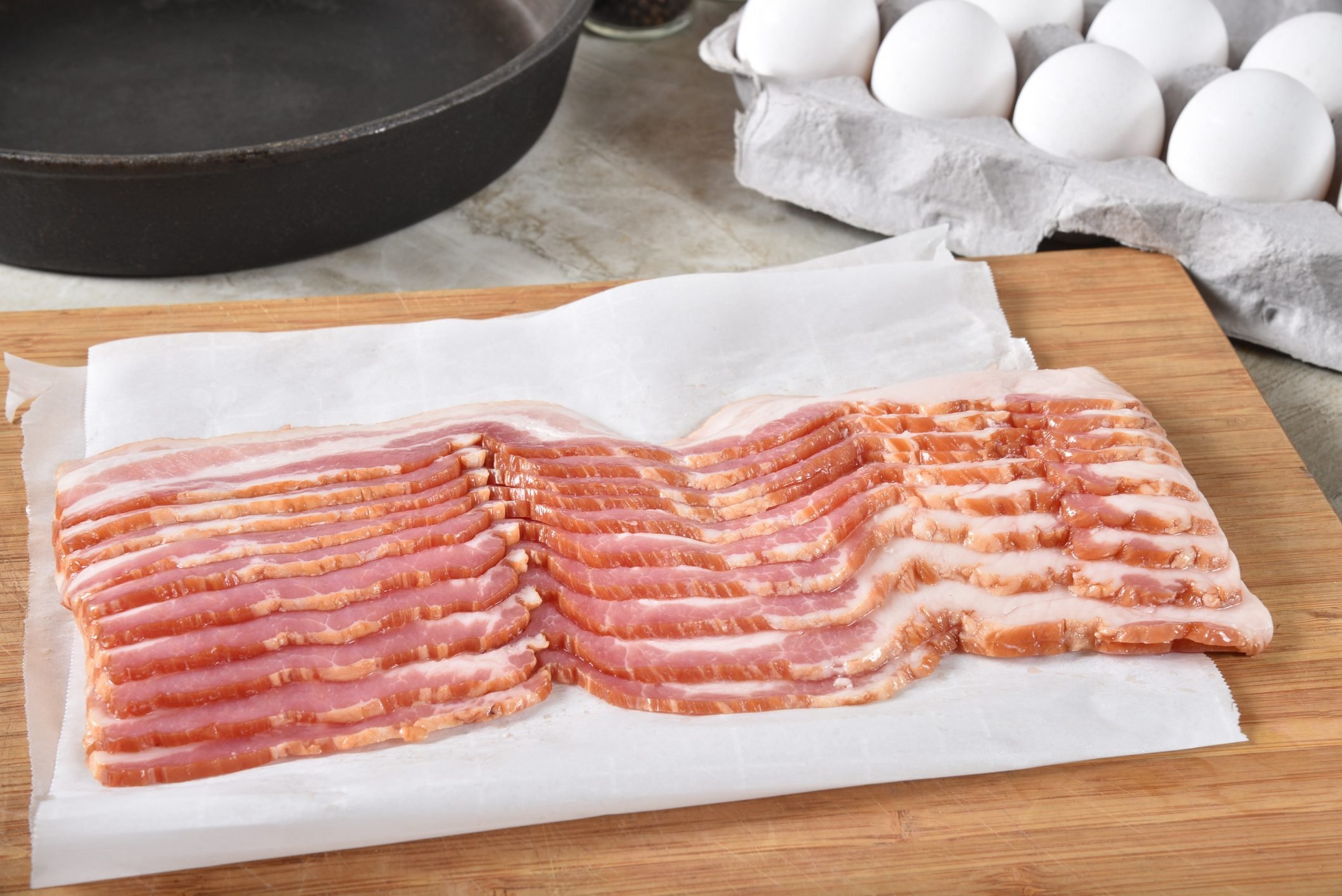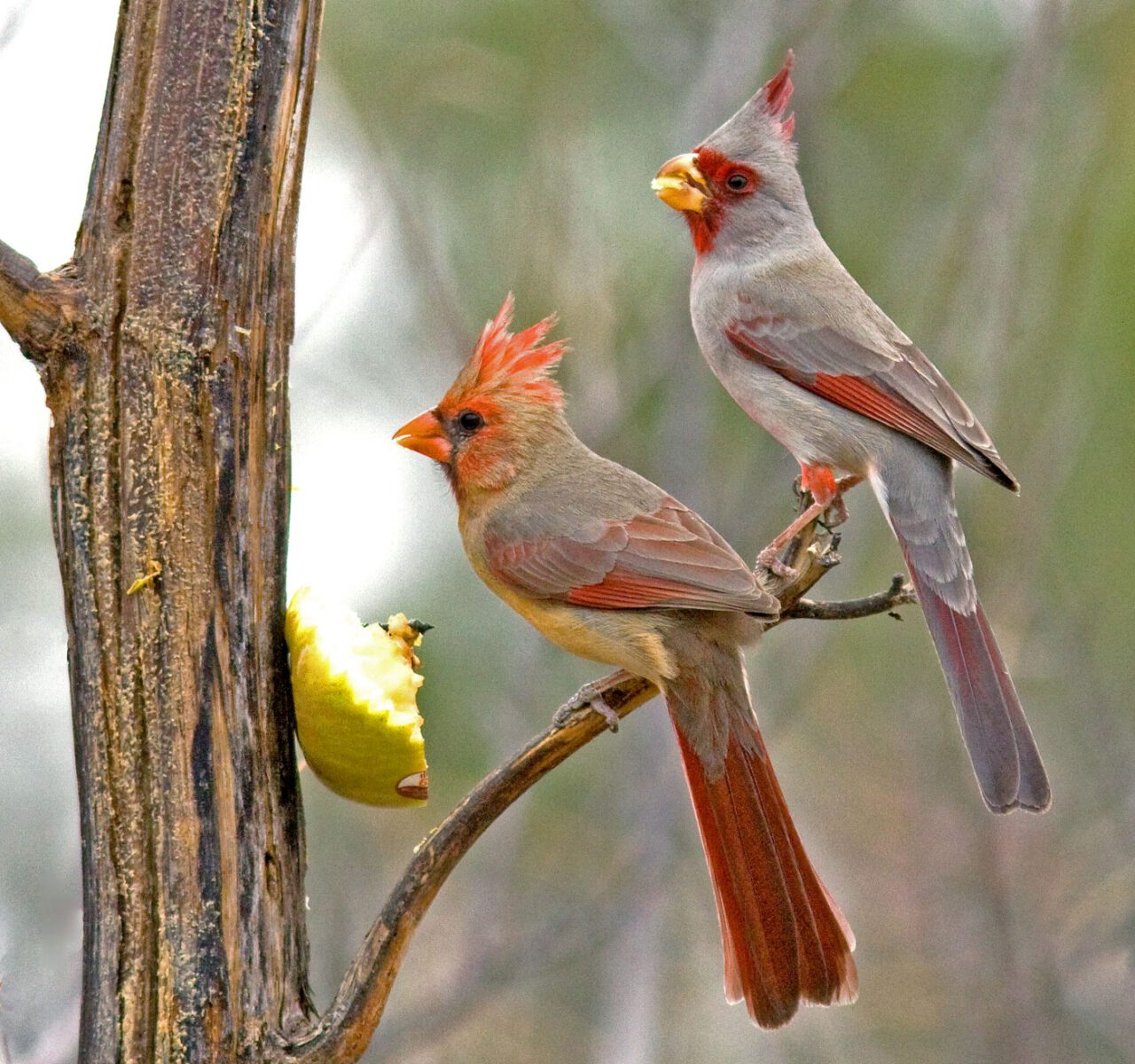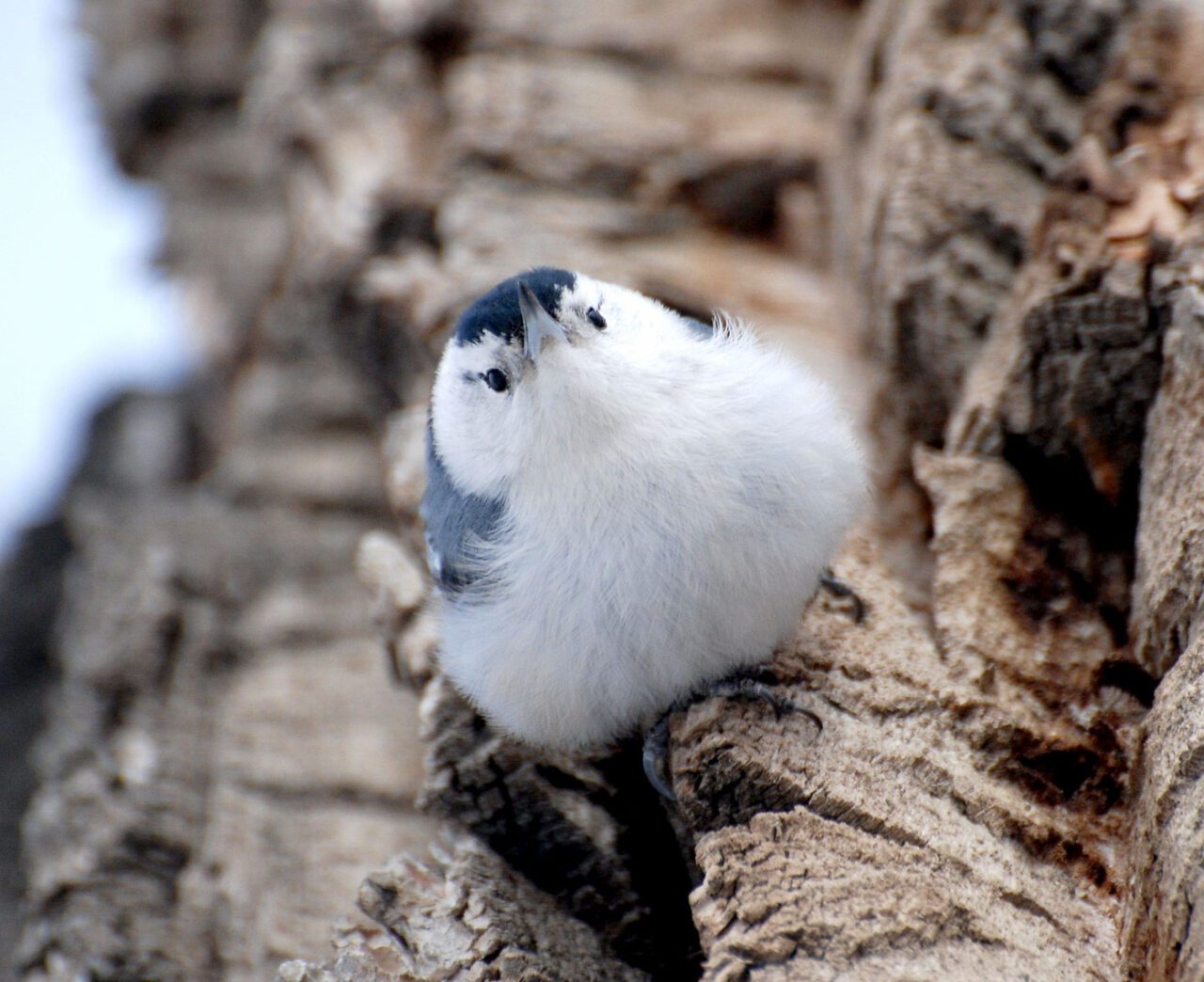Birds will come to your yard if you feed them seeds, but seeds aren’t the only food group out there. Birds eat a lot of different things, and the foods below will help you get even more kinds of birds.
Technically, suet is the hard fat around the kidneys and loins of beef and mutton. However, most types of beef fat are also called suet and are safe for birds to eat. Suet is particularly attractive to woodpeckers, nuthatches, chickadees, jays, and starlings. Wrens, creepers, kinglets, and even cardinals and some warblers occasionally visit suet feeders. Many birds can easily digest and use animal fat as fuel. It’s a high-energy food that is especially useful when it’s cold outside.
Raw suet grows rancid quickly when temperatures are above freezing; don’t offer that except in winter. When the impurities are taken out of suet by “rendering” it, it keeps much longer, but it can still get soft in warm weather. Suet that gets too soft can cover the belly feathers, which is dangerous, especially in the spring and summer when birds are incubating because the eggs may get clogged up with tiny pores that stop the embryo from getting enough oxygen.
Suet cakes are blocks that are made from suet or a thick substitute mixed with other things like peanuts, fruits, corn meal, or even dried bugs. To avoid getting sick, it’s important to either make your own suet cakes or buy them from trustworthy sellers since corn and peanuts can hold bacteria. It may be prudent to keep suet cakes made with corn, cornmeal, or peanuts refrigerated until using.
Starlings are very fond of suet. To dissuade them, offer suet in a feeder that requires birds to feed hanging upside down. Woodpeckers, chickadees, and nuthatches will access it easily, but starlings cannot.
In winter, especially in cold climates, peanut butter is a nutritious food to offer birds. Peanut butter sold in stores is certified safe for people to eat, and it’s also safe to give to birds when it’s cold enough to keep it hard. In warmer weather it must not be kept outside long enough to become rancid or soft.
There is some concern that soft peanut butter can stick to birds’ mouths. You can add cornmeal to make it grittier, but keep in mind that both corn and peanuts are great places for bacteria and fungi to grow, so make sure peanut butter feeders are cleaned out often. Peanut oils can separate in both pure peanut butter and in mixtures. If these oils stick to a bird’s feathers while it’s nesting, they can get into the eggs and block the pores, so never give birds peanut butter mixtures that get soft or oily.
Mealworms are larvae of a flightless insect called the darkling beetle. They are a big problem in granaries, but they are safe and easy to keep in our homes as long as we keep them in plastic bins or buckets.
Many birds, even ones that don’t usually come to feeders, can get a lot of protein, calcium, and vitamins from mealworms. However, mealworms are only as healthy as the food they are fed. If you buy a lot of them, they’ll come in wads of newspaper, and they’ll eat the paper, ink and all. So make sure to remove them from the paper as quickly as possible when they arrive. It can be hard to get them out of their packaging. To keep them from getting into your home, move them from the packaging to your buckets outside or over a very large piece of white paper. This way, you can see any mealworms that get away before they get too far. They don’t have to go far to find food, but most people don’t like the idea of them living or dead in cracks in their homes.
Fill the bottom of an ice cream bucket, dishpan, or other similar bin with about an inch or two of dry oatmeal or wheat bran to keep a lot of mealworms alive. Add chunks of raw potato or apple for moisture, and then put the mealworms in. During the nesting season, especially, you can boost the levels of many nutrients by adding powdered hand-feeding bird food (the kind that is sold as a complete diet for baby parrots that were raised by hand).
Mealworms can’t get out of a plastic container like a bucket as long as there is a wall at least two or three inches high between the inside and the outside. Store them in the coolest room in your house—a basement is often a good choice—on a surface that won’t be easy to knock over.
The North American Bluebird Society website has a lot of great information about mealworms. The Sialis website has information on how to raise them.
Many birds will eat mealworms at feeders so quickly that it is only cost-effective to put out a few at a time at feeders that birds you don’t want to help can’t get to. Small window feeders made of acrylic work well. If yours has drainage holes, make sure to plug them because mealworms can fit through surprisingly small openings. Special bluebird feeders that exclude most other birds are available commercially, or plans are available here.
Can Birds Eat Raw Bacon? A Detailed Look at the Risks
Bacon is a popular breakfast food that many people love to cook up in the mornings. If you’re an avid bird watcher, you may have noticed birds eyeing or even nibbling on raw bacon if left unattended. But is this uncooked pork treat actually safe and healthy for our feathered friends to consume?
In this comprehensive article we’ll explore the pros and cons of birds eating raw bacon. We’ll cover the potential risks any benefits, proper precautions to take, and healthier foods you can offer backyard birds instead. Let’s dive in!
The Potential Dangers of Raw Bacon for Birds
While cooked bacon scraps in moderation are unlikely to harm most birds, raw pork can pose some serious health risks. Here are some of the main concerns
-
Bacteria and Parasites – Raw, uncured pork may contain harmful bacteria like Salmonella, Listeria, E coli, and parasites like roundworms or tapeworms These can make birds seriously ill.
-
High Sodium – Bacon contains very high levels of sodium from the curing process. Excess salt can lead to dehydration, kidney damage and even death in birds.
-
Nitrates/Nitrites – These curing agents found in bacon can be toxic to birds and cause conditions like methemoglobinemia which impairs oxygen transport in the blood.
-
Fat Content – The high fat levels in bacon can lead to obesity and related issues like fatty liver disease and atherosclerosis in birds over time.
-
Choking Hazard – Raw bacon fat and skin can pose a choking hazard, especially for smaller bird species.
So while that strip of bacon may look tasty to wild birds or pet birds like parrots, it’s generally best to avoid offering raw bacon whenever possible due to the multiple risks it presents.
Nutritional Impact of Raw Bacon for Birds
In addition to potential health dangers, raw bacon has little positive nutritional value to offer most bird species.
While bacon contains some protein and fat, it is not a natural food source for birds and does not provide a balanced nutritional profile. Raw pork lacks the vitamins, minerals, carbohydrates, fiber and phytonutrients birds need from foods like seeds, fruits and vegetables.
Excess fat and sodium from bacon can actually displace healthier foods in a bird’s diet if they fill up on it. From a calorie standpoint, a few bites here and there of cooked bacon won’t hurt, but raw is still risky.
There are a few exceptions – scavenger birds like vultures and condors have evolved to eat carrion and rotting meat safely. But for most backyard and pet birds, any form of raw bacon should be considered dangerous from a food safety standpoint.
Proper Food Handling Precautions with Bacon
When cooking bacon at home, be sure to follow these precautions to keep birds safe:
-
Cook bacon thoroughly until crispy to kill bacteria and parasites. Avoid partially cooked or raw bacon scraps.
-
Don’t cook bacon outdoors where wildlife can access it.Cook only in enclosed spaces birds can’t enter.
-
Let bacon grease cool and solidify before disposing to avoid burns. Cover waste containers securely.
-
Clean up all bacon crumbs after cooking. Don’t leave residue on cooking surfaces.
-
Store packaged raw bacon securely out of reach and sight of pet birds like parrots.
-
Supervise outdoor cooking if necessary so birds cannot fly down and steal bacon.
Following basic food safety guidelines will help minimize the risks of exposing birds to raw or undercooked bacon. Prevention is key.
Healthier Food Alternatives for Birds
If you want to supplement the diets of backyard birds or pet birds safely, consider offering some of these healthier food alternatives:
-
Chopped or crushed nuts and seeds
-
Washed berries and fruits like apples or melons
-
Cooked brown rice, whole wheat pasta or oats
-
Chopped hard boiled eggs or cooked chicken (no salt or seasoning)
-
Defrosted frozen vegetables like peas, carrots or corn
-
Dry oat cereal or bird seed blends
-
Dried mealworms or crickets
-
Suet cakes or peanut butter treats (for some species)
Focus on more natural, minimally processed foods over highly preserved, cured or salty products like bacon. Offer a variety and monitor which ones your feathered friends seem to like best!
The Verdict on Birds and Raw Bacon

Fruits and fruit seeds

A lot of people in the tropics put out fruit for birds, which brings in a lot of tanagers and other birds that people in North America don’t usually think of as “feeder birds.” But robins, thrushes, waxwings, bluebirds, mockingbirds, catbirds, and tanagers can sometimes be drawn to bird feeders with fruit, even in the north. Because not many people in the US or Canada put fruit on feeders, these species haven’t eaten from feeders before, so it can be hard to get them close enough to understand what you’re trying to do. Fresh berries; chunks of fresh apples, melons, or grapes; or frozen berries, are excellent choices. Raisins or currants that have been softened by soaking in water may also be good. Orange halves are particularly attractive during spring migration, especially to orioles.
Providing fruits can cause some serious problems. It spoils quickly, so feeders must be emptied and cleaned very frequently. Offering fruit in a plastic cereal bowl makes this an easier task. Fruit unfortunately attracts ants and wasps in the summer. Luckily, there’s no reason to feed fruit in the summer and fall when there is so much fresh fruit around naturally.
Pumpkin seeds and other squash or melon seeds can be extremely attractive for birds. Dry them out in the oven or on a flat surface, and then chop them up in a food processor. This will make them easier for smaller birds to eat.
Orioles, catbirds, and sometimes Cape May Warblers can be enticed to visit feeders offering jelly. Make sure you only give out very small amounts at a time because the jelly gets very sticky and small birds can get stuck in it. Also, jelly has much higher sugar concentrations than any natural food. Adult birds probably shouldn’t avoid adding extra food to their diets when there isn’t enough food because of unusually cold weather in the spring, or in small amounts the rest of the year. Adult orioles and other birds sometimes stop by jelly for a quick snack while they look for bugs to feed their young in the summer. This won’t hurt them.

Eggshells are an excellent source of grit and calcium, but chicken eggs may harbor the salmonella bacteria. When hard-boiled eggs are cooked, the shells become germ-free. If you have eggshells that weren’t cooked, bake them at 250 degrees Fahrenheit for 20 minutes, let them cool, and then break them up into pieces smaller than a dime. When you’re not giving out seeds, put eggshells on the ground, in a dish, or on a low platform feeder.
Not recommended. It might seem like a good idea to avoid throwing away food by putting it out for birds to eat, but it’s not always a good idea. The food could go bad and be bad for the birds, and it’s likely to attract European Starlings, House Sparrows, or even worse animals like rats, mice, and raccoons.
Not recommended. Bacon drippings are animal fat just like suet, and many birds will eat it. But almost always, nitrosamines, which are formed from some of the preservatives used in bacon and are known to cause cancer, can be found in bacon. In particular, the very high cooking temperatures used to fry bacon are conducive to nitrosamine formation. In conclusion, bacon and bacon fat are too harmful to birds’ long-term health to be used, even though birds love them.

All About Birds is a free resource
Available for everyone, funded by donors like you
American Kestrel by Blair Dudeck / Macaulay Library Search for species name or keywords
Or Browse Bird Guide by Family or Shape
Need Bird ID Help? Try Merlin
Can birds eat raw bacon?
FAQ
Is raw bacon fat ok for birds?
Should bacon rind be cooked for birds?
Is Raw Meat bad for birds?
How to feed bacon fat to birds?
